Weddings are universal celebrations of love and commitment, but the way couples tie the knot varies dramatically across cultures. While white dresses and exchanging rings might be familiar in Western traditions, many cultures have developed fascinating and sometimes surprising customs that make their wedding ceremonies truly unique. From smashing dishes to kidnapping brides, these traditions reflect deep cultural values and beliefs about marriage, family, and good fortune.
1. Germany: Polterabend – The Great Dish Smashing

In Germany, the night before the wedding, friends and family gather for a tradition called Polterabend, which literally translates to “evening of making noise.” This unique celebration involves several key elements:
• The Smashing Ritual: Guests bring old porcelain dishes, plates, and pottery to smash on the ground in front of the couple’s home or venue, creating a loud, joyful commotion that can be heard throughout the neighborhood.
• Symbolic Meaning: The broken pieces are believed to bring good luck to the marriage, with the noise supposedly scaring away evil spirits and negative influences that might harm the union.
• Strict Rules: Only porcelain and pottery can be broken—never glass or mirrors, as these are considered extremely bad luck and could bring misfortune to the couple.
• Teamwork Test: After all the smashing is done, the engaged couple must work together to clean up all the broken pieces, symbolizing their first official task as a team and demonstrating their ability to work together through difficult situations.
2. India: Kumbh Vivah – Marrying a Tree
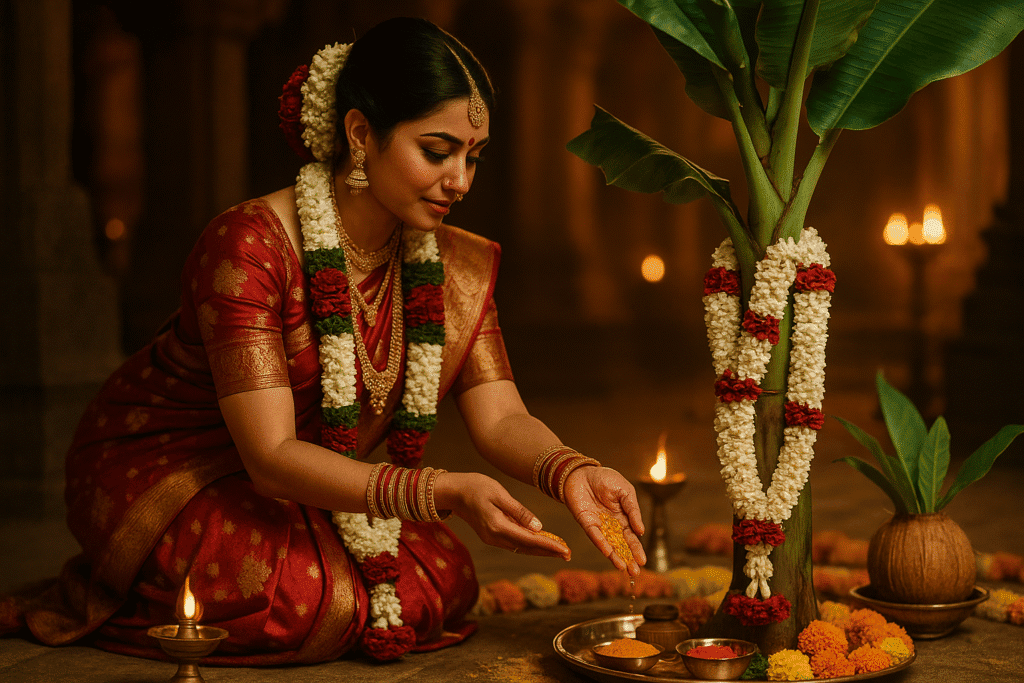
In certain regions of India, particularly among some communities, women born during inauspicious astrological periods may participate in Kumbh Vivah before their actual wedding. This fascinating ritual includes several important components:
• Symbolic Marriage: The bride ceremonially marries a banana tree, peepal tree, or sometimes a silver or gold idol of the Hindu god Vishnu, complete with traditional wedding rituals and mantras.
• Astrological Protection: The purpose is to ward off negative effects believed to be associated with the bride’s birth chart, which could potentially bring harm or misfortune to her future husband.
• Ritual Completion: After the symbolic marriage ceremony, the tree is cut down or the idol is immersed in water, symbolically transferring any bad luck away from the actual marriage.
• Cultural Significance: This tradition reflects the deep influence of astrology in Indian culture and demonstrates the lengths families will go to ensure a blessed and protected union for their children.
3. Romania: Mock Kidnapping of the Bride
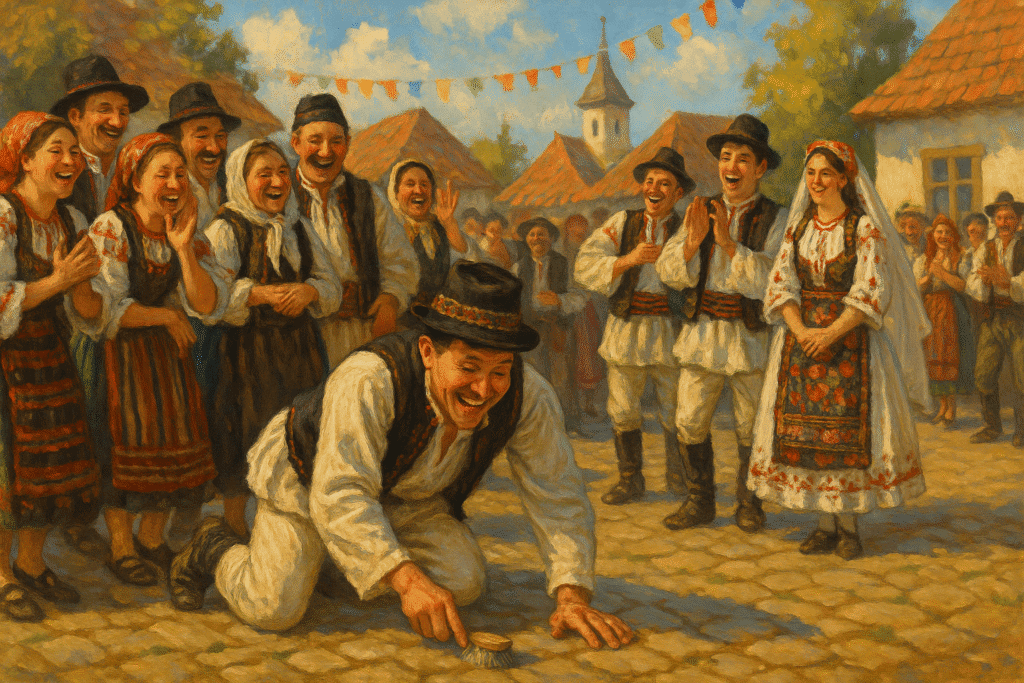
Romanian weddings feature a playful tradition where the bride is “kidnapped” during the reception by friends, family members, or even strangers. This entertaining custom involves several stages:
• The Kidnapping: During the wedding reception, a group of conspirators secretly takes the bride away from the celebration to a local pub, restaurant, or hidden location while guests continue celebrating.
• Ransom Demands: The kidnappers contact the groom and demand a ransom, which typically involves him performing embarrassing tasks, singing love songs, declaring his devotion publicly, or paying for drinks for everyone present.
• Public Display: The groom must often make a spectacle of himself in front of wedding guests and strangers, proving his love and dedication to his bride through humorous or challenging tasks.
• Joyful Resolution: Once the ransom is paid and tasks completed, the bride is returned to great celebration, creating memorable moments that the couple will laugh about for years to come and testing the groom’s commitment in a lighthearted way.
4. China: Crying Ritual in Tujia Culture
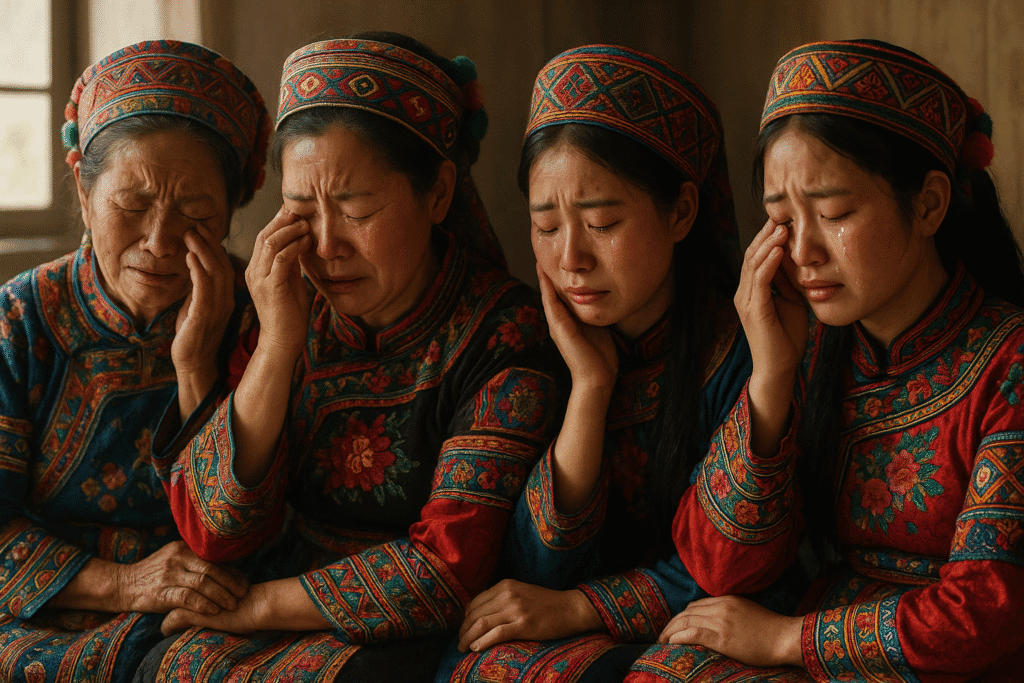
Among the Tujia people in China’s Hunan province, brides participate in a month-long crying ritual before their wedding. The bride begins crying for one hour every day a month before the ceremony. After ten days, her mother joins the daily crying sessions, and ten days later, the grandmother and other female relatives participate as well.
The crying songs express gratitude to parents, sadness about leaving the family home, and hopes for happiness in married life. Rather than being seen as sorrowful, this tradition is considered a beautiful expression of familial love and is believed to bring good fortune to the marriage. Brides who can cry melodiously are even admired for their skill.
5. Scotland: Blackening the Couple

In some parts of Scotland, particularly in rural areas, there’s a pre-wedding tradition called “blackening” where friends and family members capture the bride and groom (separately or together) and cover them with various unpleasant substances. These might include molasses, flour, feathers, eggs, fish, or even mud and soot.
After the blackening, the couple is paraded through the streets while people bang pots and pans, creating a noisy spectacle. The belief is that if a couple can endure this humiliation and mess together, they can handle anything marriage throws at them. This tradition is thought to ward off evil spirits and bring good luck to the union.
6. France: La Soupe – The Toilet Bowl Tradition
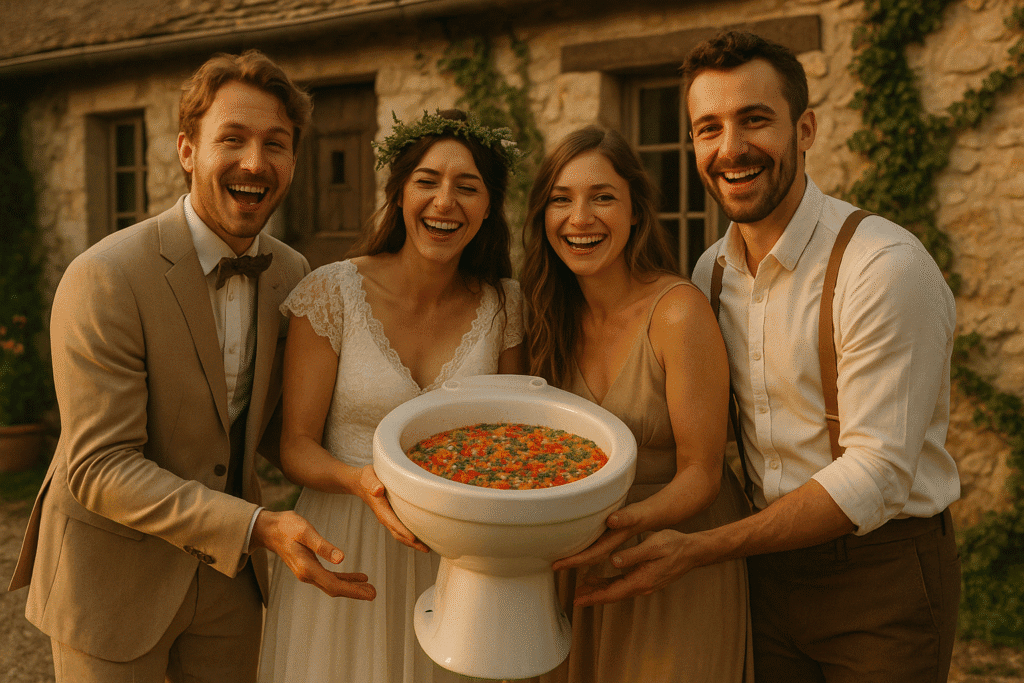
In rural France, particularly in some traditional communities, there’s an unusual post-wedding tradition called “La Soupe.” Friends of the newlyweds gather outside their bedroom window on their wedding night and create a concoction of leftover food scraps, alcohol, and various other ingredients, which they serve in a toilet bowl or chamber pot.
The couple is expected to drink this mixture together, symbolizing that they must face life’s unpleasant moments as a team. While this tradition has become less common in modern times, it still occurs in some traditional French communities as a test of the couple’s commitment and their ability to handle embarrassing situations together.
7. South Korea: Beating the Groom’s Feet
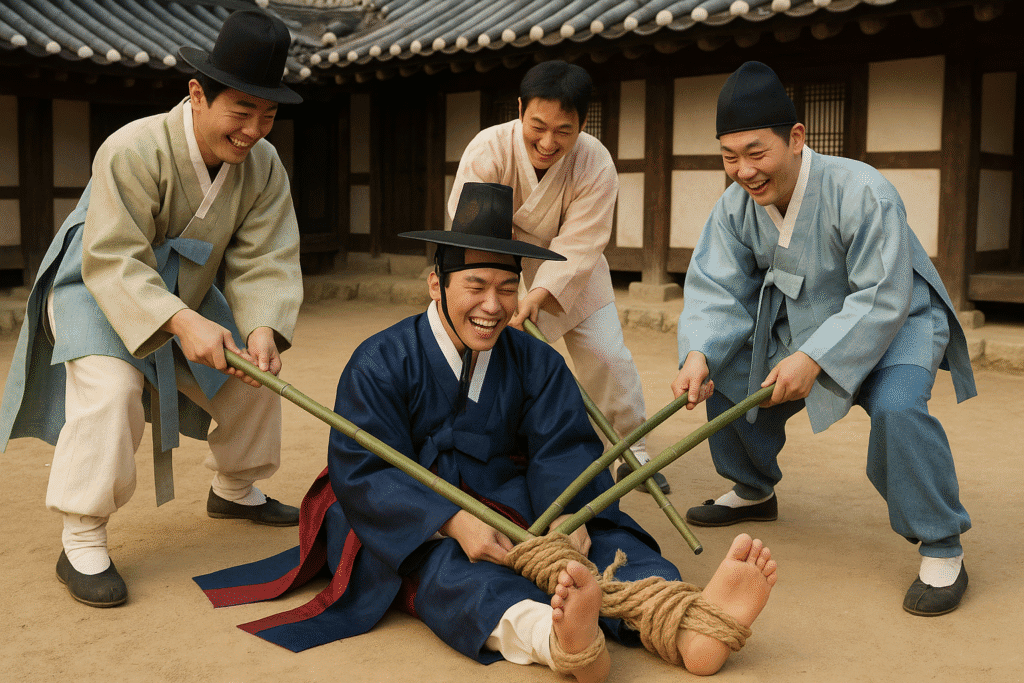
In South Korea, there’s a wedding tradition called “Falaka” where the groom’s friends remove his shoes and socks, tie his ankles together, and beat the soles of his feet with sticks, dried fish, or bamboo canes. During this ritual, they ask him questions about his bride or his future plans, and he must answer while enduring the foot beating.
This tradition serves as both a test of the groom’s strength and dedication to his bride, and as a form of entertainment for wedding guests. The beating is usually more playful than painful, and it’s believed to prepare the groom for the challenges of married life while ensuring he will be a strong and capable husband.
8. Kenya: Spitting for Blessings in Maasai Culture

Among the Maasai people of Kenya and Tanzania, wedding ceremonies include a unique blessing ritual where the bride’s father spits on her head and breasts before she leaves with her new husband. This act, which might seem disrespectful in other cultures, is actually considered a profound blessing in Maasai tradition.
The spitting is believed to ensure good luck and prevent the blessing from being taken away by speaking of it directly. The bride must not look back at her village as she leaves, as this could bring bad luck to her new marriage. This tradition reflects the Maasai belief in the power of elders’ blessings and the importance of respecting cultural customs.
9. Wales: Lovespoons and Wooden Tokens
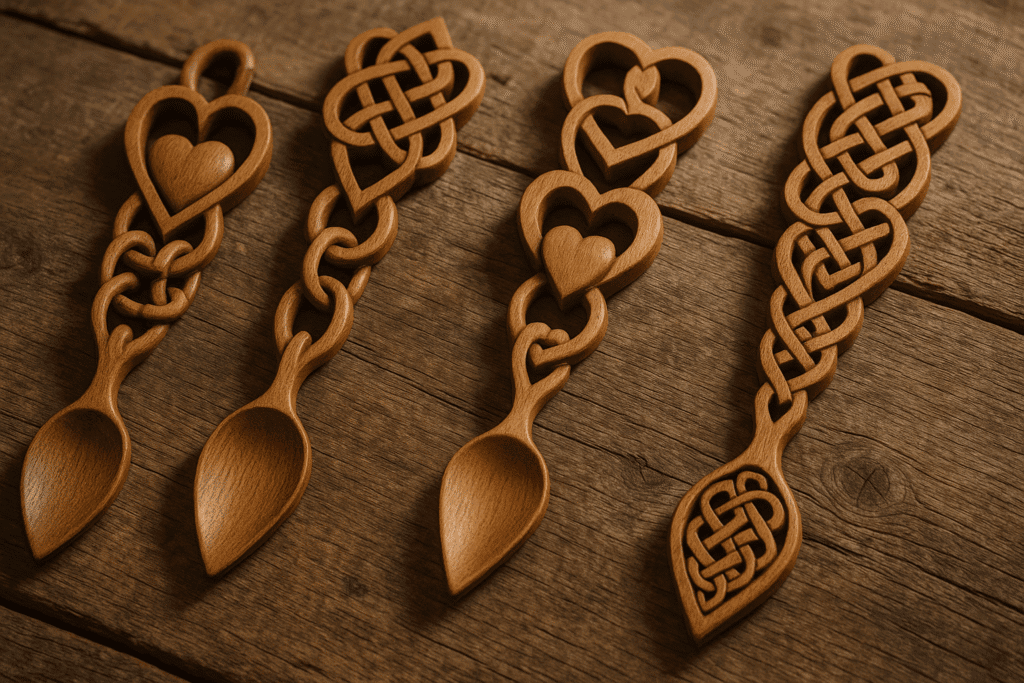
Welsh culture has a beautiful tradition of carved wooden lovespoons, where suitors would hand-carve intricate wooden spoons as a declaration of their romantic intentions. While this practice dates back several centuries, modern Welsh couples often incorporate lovespoons into their wedding ceremonies as symbols of their commitment.
The spoons feature various symbolic carvings: hearts represent love, wheels symbolize willingness to work for the loved one, and chains represent togetherness. Keys symbolize the keys to the suitor’s heart, while anchors represent settling down. These lovespoons are often exchanged during the ceremony or displayed prominently at the reception as a nod to Welsh heritage.
10. Russia: Bitter Wedding Toasts

Russian weddings feature a unique tradition where guests repeatedly shout “Gorko!” (meaning “bitter!”) throughout the reception. When this happens, the newlyweds must kiss to sweeten the bitter taste. The longer and more passionate the kiss, the more the crowd cheers and the sweeter the marriage is believed to become.
This tradition can happen dozens of times throughout the wedding celebration, ensuring that the couple shares many kisses and providing entertainment for guests. Sometimes guests will clink their glasses with spoons or knives to initiate the “Gorko!” chant, and the couple has no choice but to comply with a kiss.
Regional Comparison of Wedding Traditions
| Region | Tradition | Purpose | Modern Practice |
|---|---|---|---|
| Europe | Dish Breaking (Germany) | Ward off evil spirits | Still common in rural areas |
| Europe | Blackening (Scotland) | Test couple’s resilience | Declining but persistent |
| Asia | Tree Marriage (India) | Remove astrological curses | Practiced in traditional families |
| Asia | Crying Ritual (China) | Express family love | Maintained in Tujia communities |
| Africa | Spitting Blessing (Kenya) | Ensure good fortune | Central to Maasai ceremonies |
| Americas | Lovespoons (Wales ancestry) | Symbol of commitment | Revival in Welsh-American communities |
Common Themes Across Cultures
Despite their apparent differences, these unusual wedding traditions share several common themes that reveal universal human concerns about marriage:
• Protection and Good Luck: Many traditions, from dish smashing to spitting blessings, are designed to ward off evil spirits and ensure good fortune for the couple, reflecting a universal desire to protect new marriages from harm and give them the best possible start.
• Testing the Relationship: Several customs, such as Scotland’s blackening or South Korea’s foot beating, deliberately put couples through challenging or embarrassing situations to strengthen their bond and prove their commitment to facing life’s difficulties together.
• Community Involvement: Most of these traditions require active participation from family and friends, emphasizing that marriage is not just a union between two individuals but a joining of entire communities that creates a support network for the new couple.
• Symbolic Purification: Many cultures include elements of cleansing or purification in their wedding rituals, whether through washing ceremonies, dietary restrictions, or symbolic acts like crying rituals that represent the transition from single to married life.
• Fertility and Prosperity: Several traditions incorporate symbols or actions meant to ensure the couple will have children and prosper financially, reflecting universal hopes for abundance and continuation of family lines.
• Strength and Endurance: Many customs test the couple’s ability to endure hardship together, preparing them psychologically for the challenges that marriage may bring throughout their lives.
The Evolution of Wedding Traditions
As globalization continues to influence cultural practices, many of these unusual wedding traditions are evolving or disappearing altogether. Younger generations in urban areas often opt for more modern, Westernized ceremonies while sometimes incorporating select elements of their cultural heritage.
However, many couples are also rediscovering and embracing their ancestral traditions as a way to connect with their cultural identity and create unique, meaningful wedding experiences. This has led to fusion weddings that blend traditional customs with contemporary elements, creating new traditions for future generations.
The persistence of these unusual wedding traditions demonstrates the enduring human need for ritual, community, and meaning in our most important life transitions. While the specific practices may seem strange to outsiders, they all serve the fundamental purpose of celebrating love, ensuring good fortune, and strengthening the bonds between couples and their communities.
Understanding and appreciating these diverse wedding traditions offers us a window into different cultures and reminds us that while love is universal, the ways we celebrate it are beautifully varied. Whether through smashing dishes or carving lovespoons, each tradition reflects the unique values, beliefs, and hopes that different cultures bring to the celebration of marriage.



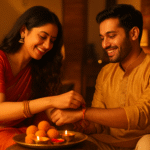


Leave a Comment